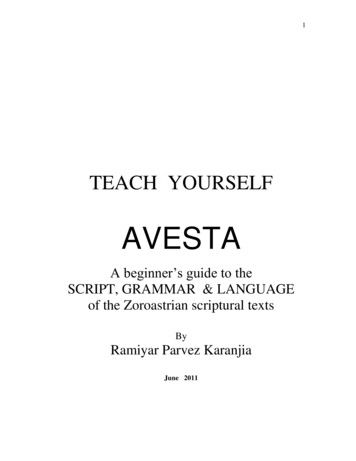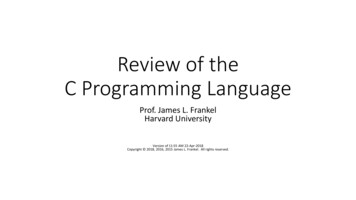
Transcription
1TEACH YOURSELFAVESTAA beginner‟s guide to theSCRIPT, GRAMMAR & LANGUAGEof the Zoroastrian scriptural textsByRamiyar Parvez KaranjiaJune 2011
2TABLE OF CONTENTSContentsIntroduction. 4I. THE AVESTAN ALPHABET . 51. The Avestan characters (1) . 72. The Alphabets (2) . 83. The Alphabets (3) . 94. The Alphabets (4) . 115. Phonetic divisions of the Alphabets . 136. Orthographic rules for placement of letters . 15II. SANDHI. 161. Vowel Sandhi. 162. Consonantal Sandhi . 19III. ROOTS & THEIR GRADATIONS . 211. Roots . 212. Vowel Gradation (Guna and Vriddhi) . 22IV. NOUNS . 241. Primary and Secondary Nouns . 24V. ADJECTIVES . 25Degrees of Adjectives . 26VI. GENDERS . 27VII. DECLENSIONS . 281. General Case Terminations. 292. Vowel Bases . 301. Bases ending in a- Masculine . 302. Bases ending in a- Neuter . 313. Bases ending in A- Masculine. 314. Bases ending in A- Feminine . 325. Bases ending in i- Masculine . 346. Bases ending in i- Feminine. 347. Bases ending in i- Neuter . 348. Bases ending in u- Masculine . 359. Bases ending in u- Feminine . 3510. Bases ending in u- Neuter . 363. Consonantal Bases . 371. Bases ending in T(Na)- Masculine. 372. Bases ending in T(At)- Feminine . 383. Bases ending in T(aw)- Neuter . 384. Bases ending in n- Masculine . 395. Bases ending in n- Feminine . 396. Bases ending in n(am)- Neuter . 40
37. Bases ending in r- Masculine . 408. Bases ending in r(at)-Masculine . 419. Bases ending in h(MaB)- Masculine . 4110. Bases ending in h(Ma)- Neuter . 42VIII. PRONOUNS . 43IX. NUMERALS . 46X. VERBS. 481. Ten Classes of Conjugation . 482. Conjugational Tenses and Moods . 511. Present Tense . 512. Imperfect Tense . 533. Imperative Mood . 544. Potential Mood. 553. Non-conjugational Tenses and Moods . 571. Future Tense . 572. Perfect Tense . 583. Aorist Tense . 584. Precative or Benedictive Mood . 59XII. PARTICIPLES . 611. Present Participle . 612. Future Participle. 613. Perfect Participle . 624. Past Participle . 62XIII. DERIVATIVE VERBS . 631. Frequentative or Intensive verb . 632. Desiderative Verb . 643. Denominative or Nominal Verb . 644. Causal Verb . 645. Incohative Verb . 65XIV. PARTICLES . 661. Adverbs . 662. Prepositions. 663. Conjunctions . 674. Prefixes . 67XV. SOME GRAMMATICAL RULES. 681. Reduplication . 682. Compounds . 693. Insertion of redundant letters . 704. Strong and Weak bases . 705. Infinitive verbs . 716. Gerund or Verbal Nouns . 71XVI. TRANSLATION . 721. Syntax - Formation of Sentences . 721. Translate from Avesta to English . 733. Translate from English to Avesta . 744. Specimen Translation of a text –SROSH BĀJ . 75QUESTION BANK . 85KEY TO EXERCISES . 88
4IntroductionAvesta, originally a language of the ancient Indo-Iranian stock of languages, is presentlythe language of the Zoroastrian scriptures. It is no more used for day to daycommunication purposes, and hence is referred to as a „dead language.‟This elementary book, helps beginners to study the Avestan script, learn the language andunderstand its basic texts. It is prepared in the format of „Teach Yourself‟ books, with theview that a student may learn the language without much help from a tutor. Each chapteris prepared as a separate unit. Most footnotes provide alternative words or contemporaryversions of grammatical terminologies. They are intended for reference and are notessential to learning the language.Exercises have been provided at the end of each chapter along with keys to most exercisesat the end of the book. A Question Bank has been provided at the end for those who wantto evaluate themselves.The book is based on the Avesta grammar notes given by late Dasturji Dr. HormazdyarKayoji Mirza to his students. The style, content and layout of this book is a result of theteaching experience and interaction during the past several years.Considering the elementary nature of the book, grammatical rules have been simplified.Wherever there are multiple options in terminations, only the most frequently usedalternative has been given in the book. This book may also be used as a sourcebook forteaching Avestan script and grammar.To study Avestan grammar in greater detail one may refer to “A Practical Grammar of theAvesta language” by Kavasji Edalji Kanga (Bombay, 1891), “An Avesta Grammar incomparison with Sanskrit” by A.V.Williams Jackson (Stuttgart, 1892), “AvestanLanguage III. The Grammar of Avestan” by Karl Hoffmann (Encyclopaedia Iranica III,pp.35-44) and An Introduction to Young Avestan by P. O. Skjaervo (Online, 2003).I hope this book will enable people to get familiar with the Avestan script, grammar andlanguage.Ramiyar Parvez KaranjiaDadar, Mumbai.June 2011.
5I. THE AVESTAN ALPHABETThe Avestan languageAvesta is the oldest extant Iranian language. It belongs to the Indo-Iranian family oflanguages. It is the mother of other Iranian languages like Old Persian, Middle Persian,Kurdish, Pashtu and Ossetic. Avesta heads the Iranian branch of Indo-Iranian language,just as Vedic Sanskrit is the source for the Indian branch, which has languages likeHindustani, Bengali and Marathi. The striking similarity between Vedic Sanskrit andAvestan is on account of their common origin.The Iranian language family can be understood as follows:LanguageHypothetical proto-Aryan language (now lost)AvestaOld PersianInscription PahlaviPahlavi (Middle Persian), Manichaenian, Tokharish etc.Neo-PersianPeriodProto-Aryan periodPeshdad-Kayan periodAchaemenianAshkanian & early SasanianSasanianPost-SasnianOther important languages in the Indo-European family are Armenian, Baltic –Lithuanian, Latvian, Old Prussian, Anatolian – Hittite, Celtic – Hittite, Gallic, Hispanic,Irish, Scot, Welsh, Tocharian, Hellenic – Classical Greek – Modern Greek, Germanic –Old Saxon – Modern German, Norwegian, Icelandic, Italic and Latin.Account of the Avestan textsAvestan texts were composed in absolute prehistory
view that a student may learn the language without much help from a tutor. Each chapter is prepared as a separate unit. Most footnotes provide alternative words or contemporary versions of grammatical terminologies. They are intended for reference and are not essential to learning the language. Exercises have been provided at the end of each chapter along with keys to most exercises at the end .File Size: 1MBPage Count: 93











